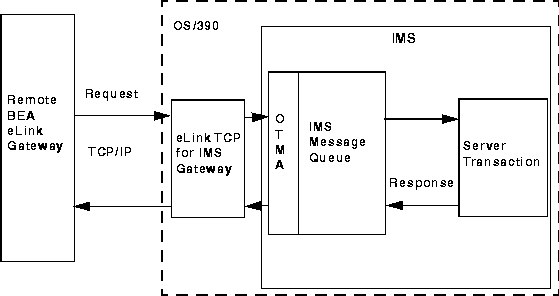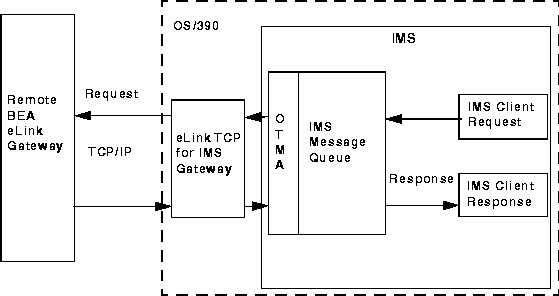
HOME | SEARCH | CONTACT | PDF FILES | WHAT'S NEW
TABLE OF CONTENTS | PREVIOUS TOPIC | NEXT TOPIC | GLOSSARY | INDEX

|
BEA eLink TCP for IMS 3.1 Information Center | |
|
HOME | SEARCH | CONTACT | PDF FILES | WHAT'S NEW |
||
|
TABLE OF CONTENTS | PREVIOUS TOPIC | NEXT TOPIC | GLOSSARY | INDEX |
||
The following information helps you understand how BEA eLink for Mainframe TCP for IMS (hereafter referenced as eLink TCP for IMS) works:
As shown in Figure 2-1, the eLink TCP for IMS gateway serves as the interface between IMS and remote BEA eLink gateways via TCP/IP.
The gateway "listens" for incoming TCP/IP connection requests from remote gateways. When a request is received, an inbound session is established over which the remote gateway can present requests for service.
As shown in Figure 2-2, when a request is received from a remote system, it is relayed to IMS which schedules the appropriate server transaction to process the request. If a response is required, the server transaction places the response in the IMS message queue. If the eLink TCP gateway is running as a BMP, the BMP retrieves the response from the Message Queue. If the eLink TCP gateway is running as an OTMA client, the response is queued to the transaction pipe and delivered to the client through cross-system coupling facility (XCF). The response is returned to the remote system over the TCP/IP connection.
The eLink TCP for IMS product can also initiate TCP/IP connections with remote systems. These outbound sessions are used to send IMS client requests to remote systems for processing.
As shown in Figure 2-3, an IMS client transaction initiates a request by placing a properly formatted message into the IMS message queue when running the gateway as a BMP. When running the gateway as an OTMA client, two IMS user exits must be installed to route messages to the OTMA client. (For more information about request/response processing, refer to "Programming BEA eLink TCP for IMS," and for sample user exits, refer to "Sample JCL and User Exits.") The gateway retrieves the request and forwards it to the appropriate remote system for processing. When the response (if required) is received from the remote system, it is returned to IMS for delivery to a transaction that processes the response.
The eLink TCP for IMS gateway is started by submitting the appropriate JCL (or as a started task) for a batch job or an OTMA client. The following activities then occur.
Figure 2-1 IMS Processing

Inbound Processing
Figure 2-2 IMS Inbound Processing

Outbound Processing
Figure 2-3 IMS Outbound Processing

How BEA eLink TCP for IMS Is Initialized
An IMS server request, also referred to as an inbound request (relative to IMS), is a request issued by a remote client for a service provided by an IMS server transaction.
An IMS client request, also referred to as an outbound request (relative to IMS), is a request issued by an IMS application message processing program (MPP) for a service provided by a remote system.
Because of the design philosophy of IMS, processing of an IMS client request occurs in two distinct "phases."
Transactions T1 and T2 may in fact be the same transaction ID (with appropriate logic to perform the required request or response processing, based on execution context). T1 and T2 must be two distinct transaction executions. This distinction is necessary because T1 can only initiate a request; it cannot "wait" on the response to that request because the architecture and design philosophy of IMS does not permit this.
Note:
For information about the IMS user exits, refer to "Sample JCL and User Exits."
Once started, eLink TCP for IMS normally executes as a non-ending job, servicing inbound requests from remote systems and outbound requests originated by IMS client transactions.
Normal termination is initiated when a system operator issues the SHUTDOWN command. In response to a SHUTDOWN command, eLink TCP for IMS performs the following tasks.